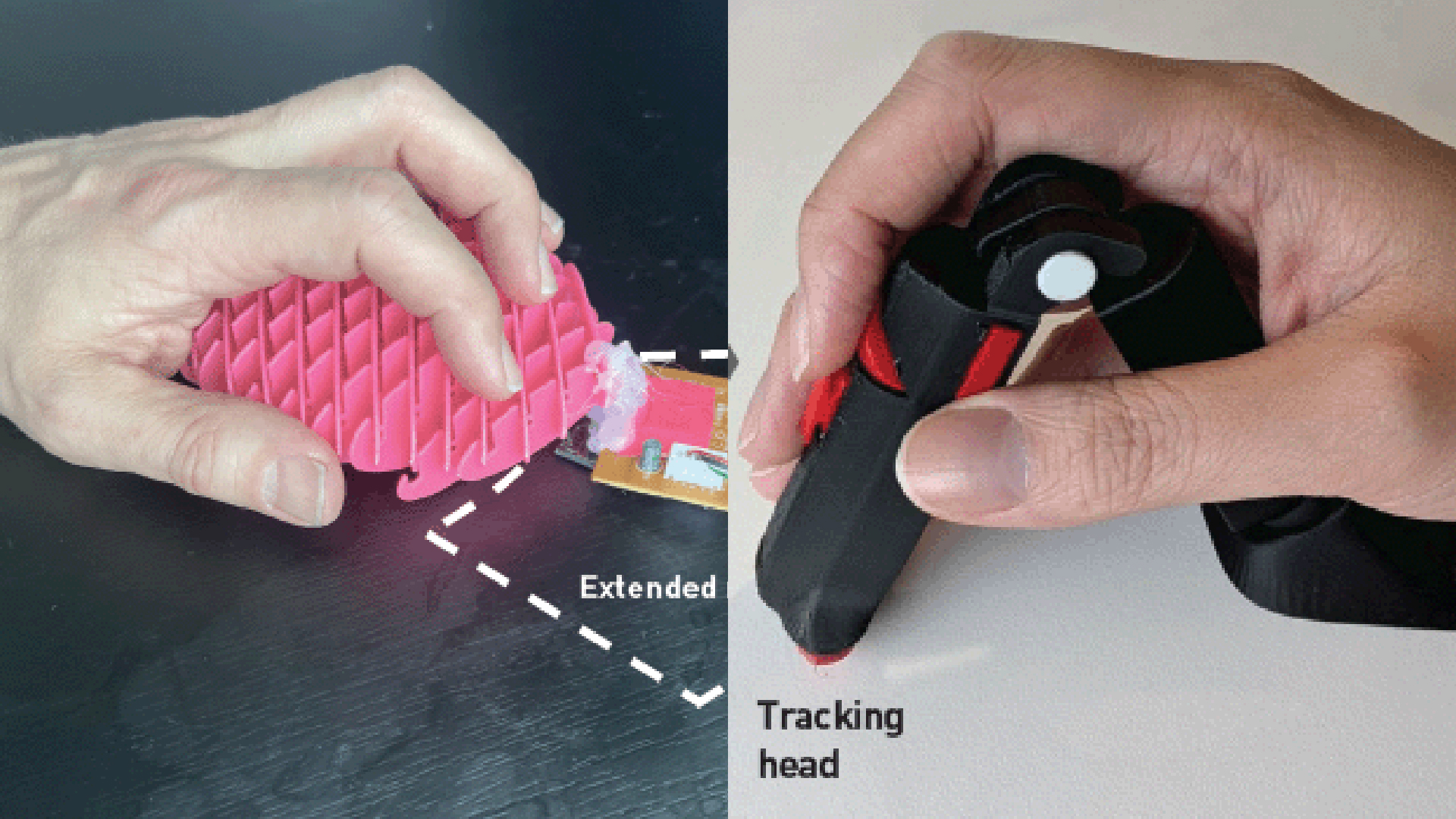Farewell to the computer mouse? Bizarre new designs could reduce wrist injuries, scientists say.
By Owen Hughes
Copyright livescience

Skip to main content
Close main menu
Live Science
Sign up to our newsletter
View Profile
Search Live Science
Planet Earth
Archaeology
Physics & Math
Human Behavior
Science news
Life’s Little Mysteries
Science quizzes
Newsletters
Story archive
CDC changes measles vaccine guidance
Skyscraper-sized asteroid flyby
Mysterious hand positions on Maya alter
It’s too late to stop AI, readers say
Anthropologist Ella Al-Shamahi on human origins
Don’t miss these
Electronics
Scientists invent weird, shape-shifting ‘electronic ink’ that could give rise to a new generation of flexible gadgets
Human Evolution
Gene that differs between humans and Neanderthals could shed light on the species’ disappearance, mouse study suggests
Medicine & Drugs
Scientists gave mice flu vaccines by flossing their tiny teeth — and it worked
Electronics
Electronics breakthrough means our devices may one day no longer emit waste heat, scientists say
New ‘breathalyzer’ could detect signs of disease in human breath, scientists say
Scientists develop ‘glue gun’ that 3D prints bone grafts directly onto fractures
Early test of new laser-free eye treatment shows promise
Humans may have untapped ‘superpowers’ from genes related to hibernation, scientists claim
Scientists burned, poked and sliced their way through new robotic skin that can ‘feel everything’
Breakthrough quantum computer could solve problems 200 times faster than a supercomputer
Neuroscience
Map of 600,000 brain cells rewrites the textbook on how the brain makes decisions
Memories aren’t static in the brain — they ‘drift’ over time
Electronics
New liquid metal-infused circuit board can withstand heavy damage and heal by themselves
Neuroscience
New pocket-size model of ALS ‘breathes and flows like human tissue’
Fertility, Pregnancy & Birth
Scientists invented ‘sperm bots’ that they piloted through a fake cervix and uterus
Farewell to the computer mouse? Bizarre new designs could reduce wrist injuries, scientists say.
Owen Hughes
19 September 2025
Researchers built two prototype mice, one with a squeezable body and another with a hinged A-frame, in an ergonomic overhaul of the desktop PC staple.
When you purchase through links on our site, we may earn an affiliate commission. Here’s how it works.
Researchers built two prototypes of computer mice designed to reduce wrist injuries, one with a flexible body and one with an A-frame design.
(Image credit: Jose Berengueres and Tony Yu, CC BY-NC-ND 4.0, Nazarbayev University.)
Few gadgets are as iconic as the computer mouse, which has been a staple of the desktop PC since it emerged some 60 years ago.
The design has gone through various evolutions in the decades since, from trackball to laser and wired to wireless, as well as a variety of ergonomic redesigns to improve comfort and reduce the risk of wrist strain. Even so, the fundamental form-factor has remained largely recognizable — until now.
In a new study, researchers developed two prototype mouse designs that mark a more radical departure from the norm: one with a squeezable mesh body, and another with a hinged A-frame design that stands vertically.
You may like
Scientists invent weird, shape-shifting ‘electronic ink’ that could give rise to a new generation of flexible gadgets
Gene that differs between humans and Neanderthals could shed light on the species’ disappearance, mouse study suggests
Scientists gave mice flu vaccines by flossing their tiny teeth — and it worked
Both are designed to reduce the wrist movements associated with repetitive strain injuries (RSI), which the researchers argued had not been solved by existing ergonomic designs such as slanted grips or trackballs that sit under the fingers.
“The main reason for this propagation of strain from the mouse hand to other parts of the body is that users frequently need to reposition (lift) the mouse several hundred times per hour, such as when trying to reach corners of the screen. As every mouse user is familiar with, lifting the mouse requires moving the wrist and sometimes even the forearm,” the researchers wrote in a study published in the Sept.–Oct. 2025 issue of the journal ACM Interactions.
Related: History of computers: A brief timeline
The researchers said that the prevailing cause of injury and discomfort when using mice is the fact that most designs still feature rigid outer shells.
Sign up for the Live Science daily newsletter now
Get the world’s most fascinating discoveries delivered straight to your inbox.
Contact me with news and offers from other Future brandsReceive email from us on behalf of our trusted partners or sponsorsBy submitting your information you agree to the Terms & Conditions and Privacy Policy and are aged 16 or over.
Even in the 1970s, when softer materials like rubber and silicone started appearing in the grips of tools like hammers and screwdrivers, mice continued to be made with hard casings, largely because they were cheaper and easier to manufacture.
“In our opinion, the effectiveness of ergonomic devices could improve significantly if mouse design took into consideration that users’ hands are not rigid solids. The overwhelming majority of hand tools humans use — keyboards, pencils, hammers, screwdrivers, mice — are rigid for reasons of economy and necessity,” the researchers wrote in the study.
“Advances in 3D printing, the popularity of soft robotics [and] other trends, such as flexible electronics … allow us to build consumer electronic devices that are compliant with our bodies.”
You may like
Scientists invent weird, shape-shifting ‘electronic ink’ that could give rise to a new generation of flexible gadgets
Gene that differs between humans and Neanderthals could shed light on the species’ disappearance, mouse study suggests
Scientists gave mice flu vaccines by flossing their tiny teeth — and it worked
Fleximouse and A-frame
The researchers’ first prototype, dubbed the Fleximouse, features a pliable mesh body that responds to being squeezed, meaning users can move the cursor by changing their grip instead of moving the device over a surface.
The A-frame design, meanwhile, was developed in collaboration with the Melbourne School of Design in Australia. It offers a more natural grip and is built with fewer moving parts — meaning it is less prone to wear. It also keeps the two bones in the forearm — the radius and the ulna — from being crossed all the time, as they are when the hand is lying flat, which the researchers identified as a leading cause of wrist strain.
Image 1 of 2
(Image credit: Jose Berengueres and Tony Yu, CC BY-NC-ND 4.0, Nazarbayev University.)
The Fleximouse design allows users to move the cursor by changing their grip.
(Image credit: Jose Berengueres and Tony Yu, CC BY-NC-ND 4.0, Nazarbayev University.)
The A-frame mouse provides a more ergonomic grip shape.
The two designs were tested out by 28 students at KTH Royal Institute of Technology — many of whom were gamers and frequent mouse users. Of these users, 11 had previously reported chronic discomfort as a result of extended mouse use, while four had clinically diagnosed RSIs.
RELATED STORIES
—Microsoft’s new light-based computer is inspired by 80-year-old technology — it could make AI 100 times more efficient
—Scientists cram an entire computer into a single fiber of clothing — and you can even put it through your washing machine
—World’s first silicon-based quantum computer is small enough to plug into a regular power socket
Feedback was mixed. Some participants described the Fleximouse as playful and appreciated not having to reposition their wrist as often, but others missed familiar features like the scroll wheel. The A-frame mouse also raised issues around fit, with the researchers finding that even small differences in hand size affected how comfortable or natural the grip felt. That said, both prototypes “significantly reduced wrist repositioning”, which was noted as a key contributor to discomfort.
The researchers said future work will explore how to fine-tune flexible designs, including ways to make them adjustable or more easily tailored to users’ hands — potentially offering “the same granularity as glove or shoe sizes.”
“The idea of customizing and personalizing the computer mouse — much like clothing — now seems closer to reality,” they said in the study.
Owen Hughes
Owen Hughes is a freelance writer and editor specializing in data and digital technologies. Previously a senior editor at ZDNET, Owen has been writing about tech for more than a decade, during which time he has covered everything from AI, cybersecurity and supercomputers to programming languages and public sector IT. Owen is particularly interested in the intersection of technology, life and work -– in his previous roles at ZDNET and TechRepublic, he wrote extensively about business leadership, digital transformation and the evolving dynamics of remote work.
You must confirm your public display name before commenting
Please logout and then login again, you will then be prompted to enter your display name.
Scientists invent weird, shape-shifting ‘electronic ink’ that could give rise to a new generation of flexible gadgets
Gene that differs between humans and Neanderthals could shed light on the species’ disappearance, mouse study suggests
Scientists gave mice flu vaccines by flossing their tiny teeth — and it worked
Electronics breakthrough means our devices may one day no longer emit waste heat, scientists say
New ‘breathalyzer’ could detect signs of disease in human breath, scientists say
Scientists develop ‘glue gun’ that 3D prints bone grafts directly onto fractures
Latest in Computing
Tiny cryogenic device cuts quantum computer heat emissions by 10,000 times — and it could be launched in 2026
Microsoft’s new light-based computer is inspired by 80-year-old technology — it could make AI 100 times more efficient
Scientists cram an entire computer into a single fiber of clothing — and you can even put it through your washing machine
China’s ‘Darwin Monkey’ is the world’s largest brain-inspired supercomputer
Japan launches its first homegrown quantum computer
IBM and Moderna have simulated the longest mRNA pattern without AI — they used a quantum computer instead
Latest in News
Skywatching alert! See 2 bright comets on the same night as a meteor shower this October
Saturn will be at its biggest and brightest on Sept. 21 — here’s how to see it
First-ever black hole to be directly imaged has changed ‘dramatically’ in just 4 years, new study finds
CDC committee votes to change measles vaccine guidance for young children
Farewell to the computer mouse? Bizarre new designs could reduce wrist injuries, scientists say.
New report warns that China could overtake the US as top nation in space — and it could happen ‘in 5-10 years,’ expert claims
LATEST ARTICLES
Farewell to the computer mouse? Bizarre new designs could reduce wrist injuries, scientists say.
Saturn will be at its biggest and brightest on Sept. 21 — here’s how to see it
Skywatching alert! See 2 bright comets on the same night as a meteor shower this October
CDC committee votes to change measles vaccine guidance for young children
First-ever black hole to be directly imaged has changed ‘dramatically’ in just 4 years, new study finds
Live Science is part of Future US Inc, an international media group and leading digital publisher. Visit our corporate site.
Contact Future’s experts
Terms and conditions
Privacy policy
Cookies policy
Accessibility Statement
Advertise with us
Web notifications
Editorial standards
How to pitch a story to us
Future US, Inc. Full 7th Floor, 130 West 42nd Street,
Please login or signup to comment
Please wait…



